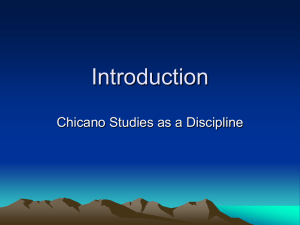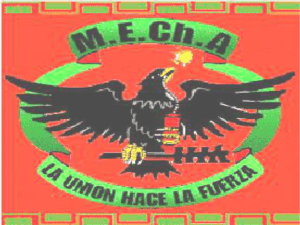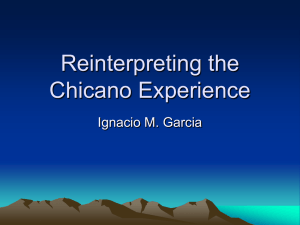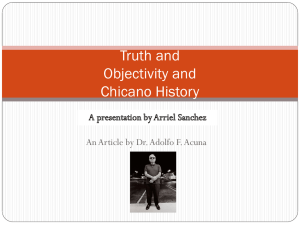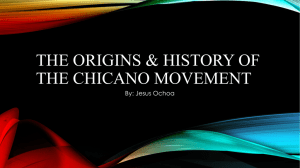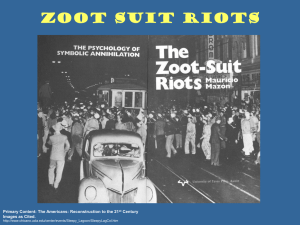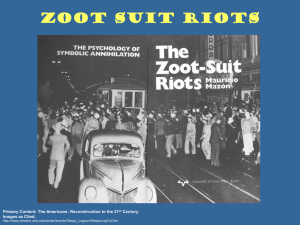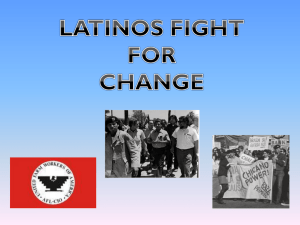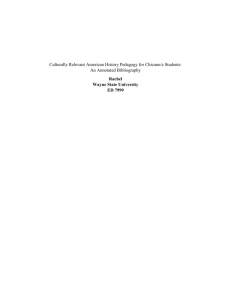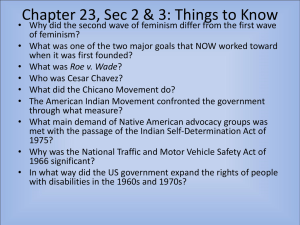The Many Roots and Branches of the Chicano Movement
advertisement
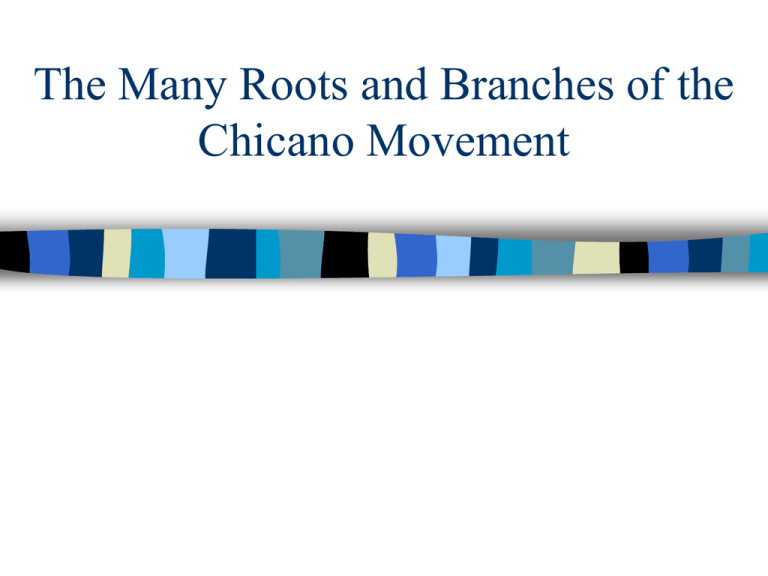
The Many Roots and Branches of the Chicano Movement Major Themes Although progress had been made prior to the Chicano Movement, Mexicans in the U.S. were still much poorer than white Americans, and segregation persisted in some schools, neighborhoods and public facilities. Many white Americans, from academics to politicians and journalists, expressed surprise when they realized Chicanos were beginning to protest their conditions publicly. Currents of confrontational protest and anti-assimilation existed throughout the 20th century in Mexican communities, but they rose to predominance during the Chicano Movement. The Chicano Movement emerged from a diverse array of political issues that were sometimes contradictory. Many Chicano Movement leaders had prior experience advocating for change in the late 1950s and early 1960s. The Black Civil Rights Movement (1955-1974) and opposition to the War in Vietnam( 1961-1975) were an important context for the rise of the Chicano Movement. Key Questions Why did the Chicano Movement occur? When did the Movement begin? When did it end? Was the Chicano Movement a continuation of previous efforts during the MexicanAmerican generation? Or was it a rejection of the strategies of the MexicanAmerican activists? How can we define the Chicano Movement? What were the politics of the Chicano Movement? Economic Results of Continued Segregation Per Ca p it a Income Percen t Li v ing in ÒDet er ior a ted HousingÓ Famil y Size Median Grad e Compl e ted Mexican Ame ricans Wh ite Ame ricans $968 $2047 29.7% 7.5% 4.77 3.39 8.1(4. 8 in Texas) 12 Source: Leo Grebler, The Mexican American People, as quoted in Acuna pg. 287. The Demise of the Bracero Program From left clockwise: Labor organizer and academic Ernesto Galarza, California Senator George Murphy and California Congressman Edward Roybal speaking at a rally. United Farm Workers From the left clockwise: Cesar Chavez on the cover of Time Magazine in 1969, Dolores Huerta speaking to workers on the Delano strike lines in 1966, Cesar Chavez and Dolores Huerta at the funeral of UFW member Juan de la Cruz killed during the second grape strike in 1973. Delano Grape Strike On left: Delano striker pleading with other farm workers to join the strike. Top right: a picket line in Delano, in the foreground are workers who were not yet on strike, the picketers carry signs saying “Huelga” which means strike. Bottom right: a picket line in Delano with many Filipino strikers. UFW and Public Support From upper left clockwise: Grape Boycott and UFW support actions in Montreal, Canada; Honolulu, Rhode Island, Boston, Milwaukee and Seattle all between 1967 and 1970. UFW and La Causa From Upper Right Clockwise: Fence painted by UFW supporters in Delano, CA ~1967; Supporters of the UFW in Wautoma, Wisconsin, 1968 who later organized other Chicano Movement activities in Milwaukee; advertisement in the Silverton-Appeal Tribune Mt. Angel News 9/11/80 for the Colegio Cesar Chavez located in Mt. Angel, Oregon from 1973-1983. Education and the Movement From Top Left Clockwise: Chicano Student High School Blowouts Los Angeles-1968; article from the Los Angeles Times about the 1968 Chicano Blowouts; Crystal City, TX High School Blowout, 1969; Students Protest Police Presence at Los Angeles High School 1970; Sal Castro, 1970. Education and the Movement On Upper Left: Los Angeles Blowouts 1968; Bottom Left: Parents speak to Los Angeles School Board in favor of student protestors in 1970; On Right: Chicano Students march from their high school to Board of Education offices in Los Angeles Higher Education and the Movement From Upper Left Clockwise: Chicana students at Colorado State University in Pueblo, Colorado protest in 1970s; Francisco Martinez a member of the university group United Mexican American Students (UMAS) speaking to high school students in 1968; Newspaper article from Seattle discussing the decision of a University of Washington chapter of UMAS to become MEChA; A Chicano Studies class taught by Raul Ruiz in 1983, Ruiz had been a key Chicano Movement activist. Chicano Youth Liberation Conference From Top Left Clockwise: Rodolfo “Corky” Gonzalez speaking in Denver in early 1970s; March to the Capitol building that took place at the end of the Chicano Youth Liberation Conference; Cover of the 1972 mass market edition of the epic poem “Yo Soy Joaquin”; the poet Alurista circa 1970. Chicano Moratorium on the Vietnam War All photographs from the Chicano Moratorium on the Vietnam War August 29, 1970. The Death of Ruben Salazar On upper left: Photo outside the Silver Dollar Bar just prior to Salazar’s death; On upper right: Ruben Salazar; On bottom left: An Chicano AntiWar March in Seattle in 1971, note the call to “Remember Reuben Salazar” on the left of the banner. Despite the spelling the intent was to memorialize Salazar, a sentiment that was widespread amongst Chicanos. Many Branches: Defining the Chicano Movement From Left Clockwise: an example of Chicano Movement art, etching by Esther Hernandez entitled “Liberty”; Boy protesting the imprisonment of members of the New Mexico organization La Alianza Federal de Mercedes; members of La Raza Unida Party supporting their candidate for the governor of Texas Ramsey Muniz; members of Catolicos por La Raza in 1969. Further Reading Donato, Rubén. The Other Struggle for Equal Schools: Mexican Americans During the Civil Rights Era. Albany, NY: State University of New York Press, 1997. Gonzales, Rodolfo. Message to Aztlán: Selected Writings of Rodolfo "Corky" Gonzales. Houston, Tex: Arte Público Press, 2001. Gutierrez, Jose Angel. The Making of a Chicano Militant: Lessons from Cristal. Madison, Wis: University of Wisconsin Press, 1998. Gutiérrez, José Angel. We Won't Back Down: Severita Lara's Rise from Student Leader to Mayor. Houston, Tex: Piñata Books, 2005. Haney-López, Ian. Racism on Trial: The Chicano Fight for Justice. Harvard University Press, 2004. Levy, Jacques E. Cesar Chavez: Autobiography of La Causa. 1st ed. Minneapolis: University of Minnesota Press, 2007. Mariscal, George. Brown-Eyed Children of the Sun: Lessons from the Chicano Movement, 1965-1975. Albuquerque: University of New Mexico Press, 2005. Martinez, Richard Edward. PADRES: The National Chicano Priest Movement. 1st ed. Austin: University of Texas Press, 2005. Muñoz, Carlos. Youth, Identity, Power: The Chicano Movement. Rev. and expanded ed. London: Verso, 2007. Pulido, Laura. Black, Brown, Yellow, and Left: Radical Activism in Los Angeles. Berkeley: University of California Press, 2006. Salazar, Ruben. Border Correspondent: Selected Writings, 1955-1970. Berkeley: University of California Press, 1995. San Miguel, Guadalupe. Brown, Not White: School Integration and the Chicano Movement in Houston. College Station: Texas A&M University Press, 2001. Treviño, Jesús Salvador. Eyewitness: A Filmmaker's Memoir of the Chicano Movement. Houston, Tex: Arte Publico Press, 2001. Vigil, Ernesto B. The Crusade for Justice: Chicano Militancy and the Government's War on Dissent. Madison: University of Wisconsin Press, 1999.
